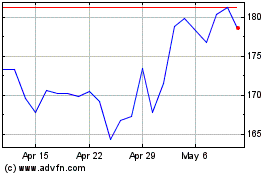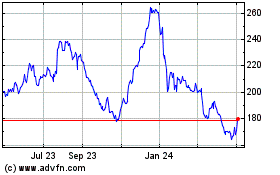By Anna Louie Sussman
WASHINGTON -- Demand for long-lasting factory goods rebounded in
July, a sign the manufacturing sector could continue to stabilize
in the second half of the year.
Much of the uptick was due to civilian aircraft orders, but
orders for core capital goods -- the kind of business investment
that has been conspicuously absent for the past few years -- --
posted their largest gain since January, suggesting firms may
finally feel comfortable making the large-scale investments that
signal confidence in future demand.
New orders for durable goods -- aircraft, industrial machinery,
and other products designed to last at least three years -- rose a
seasonally adjusted 4.4% in July from the prior month, the Commerce
Department said Thursday, the largest monthly jump since October.
Economists surveyed by The Wall Street Journal had expected a rise
of 3.2%.
A closely watched proxy for business investment, new orders for
nondefense capital goods excluding aircraft, rose for the
second-straight month, up 1.6% from June.
Back-to-back months of rising orders in this category are "an
encouraging sign that business capital investment activity might be
on the verge of a long-awaited rebound," said Millan Mulraine,
deputy chief U.S. macro strategist at TD Securities USA LLC.
"The sharp rise in core orders and modest gain in inventories to
start the quarter suggest that business investment will likely
provide a modest boost to the economic recovery," he said.
Investment in capital goods, such as machine tools or robotics
equipment, is a key ingredient in boosting workers' wages and
productivity, as well as corporate profits. Productivity, or output
per hour worked, fell in the second quarter for the third
consecutive period, the longest streak of falling productivity
since 1979.
But other economists cautioned against reading too much into the
short stretch of increased investment. Orders in that category were
still down 4.3% over the first seven months of the year, compared
with the same period a year before.
"While I am hopeful, it is more of a light at the end of the
tunnel thing than a watershed moment," said Stephen Stanley, chief
economist at Amherst Pierpont Securities. "I am looking for
business equipment spending to continue declining for the rest of
this year, reflecting election uncertainty as well as the
longstanding soft backdrop."
July's rise was led by more robust demand for transportation
equipment, orders of which rose 10.5%. That was driven by the
volatile civilian aircraft and parts category, which showed a 89.9%
increase in orders over the month. Separate data from Boeing Co.,
the largest aerospace company in the U.S., showed 73 orders for
large jets in July, up from 12 in June.
The data suggest the manufacturing sector is firming in the
second half of the year, coming on the heels of other recent
reports suggesting the U.S. manufacturing sector stabilized in
July. A Federal Reserve report showed manufacturing output posted
its largest monthly advance in a year in July. And the Institute
for Supply Management's gauge showed manufacturing activity
expanding in July for the fifth-straight month.
The latest report reflects the first full month of durable goods
data since the United Kingdom voted to leave the European Union in
late June. After the vote, the dollar strengthened further against
the British pound and euro, but it has fallen again since the end
of July.
Orders for durable goods excluding the transportation category
rose 1.5% from June, and orders excluding defense rose 3.8% last
month. Data on durable-goods orders can be uneven from month to
month and are often revised.
June's figures for overall new orders were revised to a 4.2%
decline, from an earlier estimate of a 3.9% decrease. Through the
first seven months of the year, durable goods orders were down
0.9%, compared with the same period in 2015.
After steadily climbing in the first few years of the recovery,
manufacturing output has mostly flattened in the past two years. A
sharp drop in oil prices curbed new investment in the energy
sector, and a strengthening dollar made U.S.-made goods more
expensive for overseas buyers. Still, steady hiring and low
interest rates have stoked domestic appetite for some durable
items, such as cars, helping counter the lack of capital investment
and foreign demand.
But consumer demand can only go so far in spurring economic
growth. Thursday's report showed orders for motor vehicles and
parts were flat in July.
Federal Reserve officials, who gather with other central bankers
this week for an annual conference in Jackson Hole, Wyo., face the
possibility the U.S. economy is stuck in a "new normal" of low
growth and productivity.
Demand for machinery rose 1.6%. Orders for computers and
electronic products posted their largest increase since March 2015,
up 3.6%.
Shipments of durable goods rose 0.2% during the month, but are
down 1.1% compared with shipments in the first seven months of last
year.
Write to Anna Louie Sussman at anna.sussman@wsj.com
(END) Dow Jones Newswires
August 25, 2016 12:52 ET (16:52 GMT)
Copyright (c) 2016 Dow Jones & Company, Inc.
Boeing (NYSE:BA)
Historical Stock Chart
From Mar 2024 to Apr 2024

Boeing (NYSE:BA)
Historical Stock Chart
From Apr 2023 to Apr 2024
